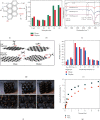Recent Advances in Carbon-Based Adsorbents for Adsorptive Separation of Light Hydrocarbons
- PMID: 35935141
- PMCID: PMC9275103
- DOI: 10.34133/2022/9780864
Recent Advances in Carbon-Based Adsorbents for Adsorptive Separation of Light Hydrocarbons
Abstract
Light hydrocarbons (LHs) separation is an important process in petrochemical industry. The current separation technology predominantly relies on cryogenic distillation, which results in considerable energy consumption. Adsorptive separation using porous solids has received widespread attention due to its lower energy footprint and higher efficiency. Thus, tremendous efforts have been devoted to the design and synthesis of high-performance porous solids. Among them, porous carbons display exceptional stability, tunable pore structure, and surface chemistry and thus represent a class of novel adsorbents upon achieving the matched pore structures for LHs separations. In this review, the modulation strategies toward advanced carbon-based adsorbents for LHs separation are firstly reviewed. Then, the relationships between separation performances and key structural parameters of carbon adsorbents are discussed by exemplifying specific separation cases. The research findings on the control of the pore structures as well as the quantification of the adsorption sites are highlighted. Finally, the challenges of carbonaceous adsorbents facing for LHs separation are given, which would motivate us to rationally design more efficient absorbents and separation processes in future.
Copyright © 2022 Yong-Sheng Wang et al.
Conflict of interest statement
The authors declare no conflict of interest.
Figures






Similar articles
-
Light Hydrocarbon Separations Using Porous Organic Framework Materials.Chemistry. 2020 Mar 12;26(15):3205-3221. doi: 10.1002/chem.201904455. Epub 2019 Dec 27. Chemistry. 2020. PMID: 31667891 Review.
-
Designer Metal-Organic Frameworks for Size-Exclusion-Based Hydrocarbon Separations: Progress and Challenges.Adv Mater. 2020 Nov;32(44):e2002603. doi: 10.1002/adma.202002603. Epub 2020 Jul 9. Adv Mater. 2020. PMID: 32644246 Review.
-
Metal-Organic Framework Materials for the Separation and Purification of Light Hydrocarbons.Adv Mater. 2020 Jan;32(3):e1806445. doi: 10.1002/adma.201806445. Epub 2019 May 20. Adv Mater. 2020. PMID: 31106907 Review.
-
Alternatives to Cryogenic Distillation: Advanced Porous Materials in Adsorptive Light Olefin/Paraffin Separations.Small. 2019 Jun;15(25):e1900058. doi: 10.1002/smll.201900058. Epub 2019 Apr 17. Small. 2019. PMID: 30993886 Review.
-
Process-Oriented Smart Adsorbents: Tailoring the Properties Dynamically as Demanded by Adsorption/Desorption.Acc Chem Res. 2022 Jan 4;55(1):75-86. doi: 10.1021/acs.accounts.1c00555. Epub 2021 Dec 17. Acc Chem Res. 2022. PMID: 34918905
Cited by
-
Probing sub-5 Ångstrom micropores in carbon for precise light olefin/paraffin separation.Nat Commun. 2023 Mar 2;14(1):1197. doi: 10.1038/s41467-023-36890-6. Nat Commun. 2023. PMID: 36864084 Free PMC article.
-
Photo-Responsive Carbon Capture over Metalloporphyrin-C60 Metal-Organic Frameworks via Charge-Transfer.Research (Wash D C). 2023 Oct 24;6:0261. doi: 10.34133/research.0261. eCollection 2023. Research (Wash D C). 2023. PMID: 37881620 Free PMC article.
-
Alginate Ag for Composite Hollow Fiber Membrane: Formation and Ethylene/Ethane Gas Mixture Separation.Membranes (Basel). 2022 Nov 2;12(11):1090. doi: 10.3390/membranes12111090. Membranes (Basel). 2022. PMID: 36363645 Free PMC article.
-
Single-Molecule Traps in Covalent Organic Frameworks for Selective Capture of C2H2 from C2H4-Rich Gas Mixtures.Research (Wash D C). 2024 Aug 26;7:0458. doi: 10.34133/research.0458. eCollection 2024. Research (Wash D C). 2024. PMID: 39188360 Free PMC article.
References
Publication types
LinkOut - more resources
Full Text Sources

